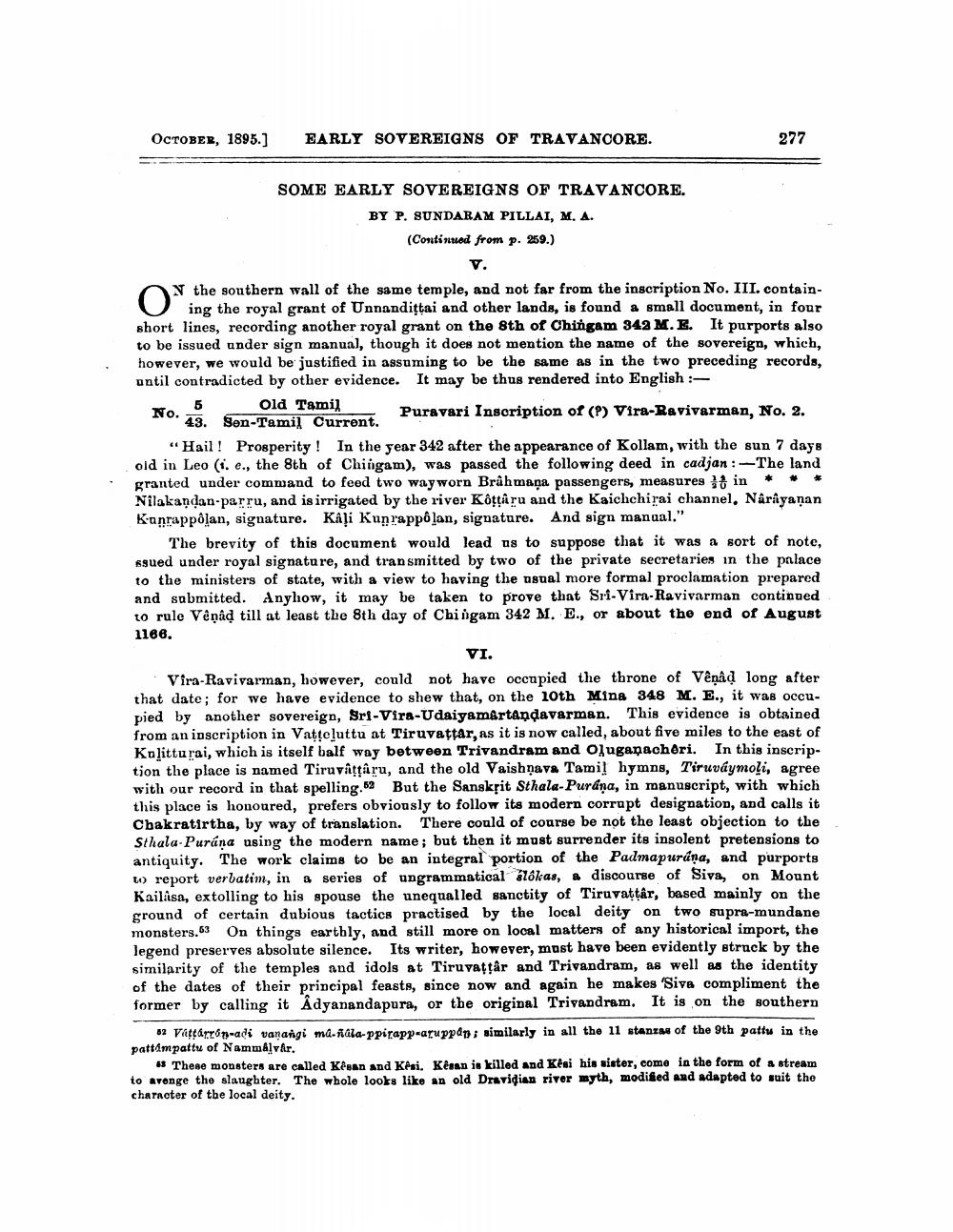________________
OCTOBER, 1895.]
EARLY SOVEREIGNS OF TRAVANCORE.
No.
SOME EARLY SOVEREIGNS OF TRAVANCORE. BY P. SUNDARAM PILLAI, M. A.
(Continued from p. 259.) V.
N the southern wall of the same temple, and not far from the inscription No. III. containmanditai other lands, is found document, in four short lines, recording another royal grant on the 8th of Chingam 342 M. E. It purports also to be issued under sign manual, though it does not mention the name of the sovereign, which, however, we would be justified in assuming to be the same as in the two preceding records, until contradicted by other evidence. It may be thus rendered into English :
Puravari Inscription of (?) Vira-Ravivarman, No. 2.
277
5
Old Tamil 43. Sen-Tamil Current.
***
"Hail! Prosperity! In the year 342 after the appearance of Kollam, with the sun 7 days old in Leo (i. e., the 8th of Chingam), was passed the following deed in cadjan:-The land granted under command to feed two way worn Brahmana passengers, measures in Nilakandan-parru, and is irrigated by the river Kôttaru and the Kaichchirai channel, Narayanan Kanrappolan, signature. Kâli Kunrappôlan, signature. And sign manual."
The brevity of this document would lead us to suppose that it was a sort of note, ssued under royal signature, and transmitted by two of the private secretaries in the palace to the ministers of state, with a view to having the usual more formal proclamation prepared and submitted. Anyhow, it may be taken to prove that Sri-Vira-Ravivarman continued to rule Vênâd till at least the 8th day of Chingam 342 M. E., or about the end of August 1166.
VI.
Vira-Ravivarman, however, could not have occupied the throne of Vênâd long after that date; for we have evidence to shew that, on the 10th Mina 348 M. E., it was occupied by another sovereign, Sri-Vira-Udaiyamartandavarman. This evidence is obtained from an inscription in Vatteluttu at Tiruvattar, as it is now called, about five miles to the east of Kalitturai, which is itself balf way between Trivandram and Oluganacheri. In this inscription the place is named Tiruvatțâru, and the old Vaishnava Tami! hymns, Tiruváymoli, agree with our record in that spelling.62 But the Sanskrit Sthala-Purana, in manuscript, with which this place is honoured, prefers obviously to follow its modern corrupt designation, and calls it Chakratirtha, by way of translation. There could of course be not the least objection to the Sthala Purana using the modern name; but then it must surrender its insolent pretensions to antiquity. The work claims to be an integral portion of the Padmapurána, and purports to report verbatim, in a series of ungrammatical slokas, a discourse of Siva, on Mount Kailasa, extolling to his spouse the unequalled sanctity of Tiruvaṭṭâr, based mainly on the ground of certain dubious tactics practised by the local deity on two supra-mundane monsters.63 On things earthly, and still more on local matters of any historical import, the legend preserves absolute silence. Its writer, however, must have been evidently struck by the similarity of the temples and idols at Tiruvatțâr and Trivandram, as well as the identity of the dates of their principal feasts, since now and again he makes 'Siva compliment the former by calling it Adyanandapura, or the original Trivandram. It is on the southern
82 Váṭṭarron-adi vanangi ma-ñala-ppirapp-aruppan; similarly in all the 11 stanzas of the 9th pattu in the pattâmpattu of Nammålvår.
5 These monsters are called Kêsan and Kêsi. Kêsan is killed and Kesi his sister, come in the form of a stream to avenge the slaughter. The whole looks like an old Dravidian river myth, modified and adapted to suit the character of the local deity.




